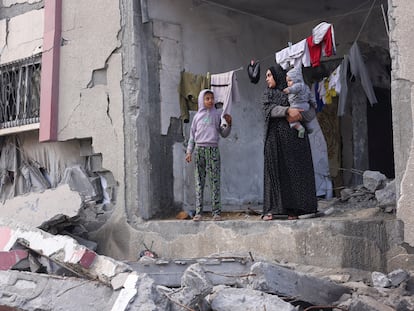Families of Israeli hostages march from the gates of Gaza to Jerusalem to call for their release
Relatives and friends of the more than 130 people being held in the Strip are demanding that Israeli authorities prioritize an agreement to bring them home

The aim is to bring to life a road that lies near the scenes of the Hamas massacre of October 7. A hundred relatives and friends of the more than 100 hostages still being held in Gaza set out on foot Wednesday morning from the vicinity of the border with the Strip, heading toward Jerusalem. The four-day march is part of a new effort to apply pressure on the government of Prime Minister Benjamin Netanyahu. The marchers want Israel to prioritize an agreement with Hamas over military operations on Palestinian soil so that their loved ones can return home.
Gadi Moses will celebrate his 80th birthday on March 12. On the 145th day of his captivity, his son Oded is one of those lining up on Road 232, which climbs northward parallel to the fence separating Israel from Gaza. “We have to reach an agreement with the enemy because the hostages will only return by political means,” he says. The wounds of the Hamas attack, which killed some 1,200 people in this area with a further 240 kidnapped, are still visible on the asphalt on which they are advancing.
That was the trigger for a war in which Israel, in retaliation, has already killed some 30,000 Palestinians in Gaza. Oded, who walks with an image of his father emblazoned on his black T-shirt, is convinced that the Israeli authorities have the capacity to stop the military operation, reach an agreement, and then put an end to Hamas. It was under these conditions that, after 49 days in captivity, his mother Margalit Moses, 77, who had been abducted like Gadi from Kibbutz Nir Oz, was released. Israel and Hamas agreed to a week-long ceasefire last November that saw the return of 105 hostages in exchange for Palestinian prisoners from Israeli jails. Negotiations to try and secure a second cessation of hostilities have been ongoing for weeks.
The organizers of the march, who in November organized a similar one from Tel Aviv to Jerusalem, chose as their starting point one of the scenes of the barbarity of October 7, the spot where the Nova festival was held, near Kibbutz Reim, and where Palestinian Islamists killed 360 people. Hundreds of messages, photos, personal objects, candles, small altars, flowers, and flags have been placed in memory of the victims of the attacks. Some are among the more than 130 hostages still in Gaza, although the authorities estimate that around 30 are already dead. “RIP Elia,” reads a message written on the trunk of a tree next to a fractured red heart and the date of the massacre.
“United for the liberation of the hostages,” is the slogan under which they will walk until Saturday, explains Ronen Neutra, father of Omer Neutra, one of the hostages. The marchers will walk a stage of between 15 and 20 kilometers per day. It is a march for “hope,” so that no one is left behind, “the living and the murdered,” he says. They consider that the entire cabinet headed by Netanyahu is “responsible” for ensuring that this agreement covers everyone, indirectly alluding to people of all ages and status, as military personnel were also captured. Like Ronen, the vast majority of the participants wore T-shirts or carried posters on wooden poles with pictures of their loved ones.
Ziv and Gali Berman, 26-year-old twins kidnapped from Kibbutz Kafar Azza, share one of those posters. It is carried by Macabit Mayer, their aunt. “They are to be released in an agreement. We are afraid that if the army goes to rescue them it would be dangerous,” she says in the company of her brother, Nir Sobol. So far only two civilians have been freed by the Israeli army in Gaza, during an unprecedented operation in Rafah, in southern Gaza, on February 12. Some of the hostages lost their lives earlier in attempts to free them in other areas of the Strip. Israeli troops also killed three hostages who were waving a white flag. “We are hopeful that things are being developed [by the government] behind closed doors. We have to trust them; we have no choice,” says Mayer.
But there are sectors of the Israeli government and society that, regardless of the hostages, advocate increased military action. “I am a family member. For me, the only way forward is an agreement. We fear for their lives. What I ask of others is to put themselves in my place. My only answer is for them to think of it as their own family. Your child, mother, father, grandmother...” says the aunt of Ziv and Gali Berman, who at the end of November were reported to be well by other hostages from their kibbutz who were released.
“The end of all this is to bring about peace with the enemy. We have to live with them,” says Oded Moses. “Years ago, we were at war with Egypt and Jordan and now we are more or less okay. I think that’s what we have to do with the Palestinians, but not with Hamas, which is a terrorist group and has nothing to do with the Palestinians’ desire for statehood,” he concludes. Moses clings to optimism about his mother’s release and to the video that the Palestinian Islamist group Islamic Jihad released on December 19, showing his father and another hostage denouncing the “unbearable” conditions of their captivity and calling on Netanyahu and other Israeli leaders to act.
The group is leaving in the direction of Sderot. Saroo, 27, has no relatives in Gaza, but has set out to reach Jerusalem barefoot. Also walking is Hadar Norany, 39, accompanied by a sign with a photo of her friend and fellow veterinarian Doron Steinbrecher, 31, who appeared a month ago in a video released by Hamas. Accompanying them all are support vehicles and a group of military personnel. Behind them are some of the patrols cutting off and directing traffic.
Before continuing in her car, officer Betty Perez tells the reporter in which direction to head. She notices that he is Spanish and exclaims. “You’re standing before an Israeli policewoman who loves flamenco and Camarón,” the 37-year-old with Moroccan-Jewish ancestors who moved to Catalonia and who declares herself a fan of Camarón de la Isla says. As proof, she sports on her left hand the same tattoo as the singer, a star and a crescent moon. “Many people here think it’s a political tattoo, but no, it’s in his honor.”
Sign up for our weekly newsletter to get more English-language news coverage from EL PAÍS USA Edition
Tu suscripción se está usando en otro dispositivo
¿Quieres añadir otro usuario a tu suscripción?
Si continúas leyendo en este dispositivo, no se podrá leer en el otro.
FlechaTu suscripción se está usando en otro dispositivo y solo puedes acceder a EL PAÍS desde un dispositivo a la vez.
Si quieres compartir tu cuenta, cambia tu suscripción a la modalidad Premium, así podrás añadir otro usuario. Cada uno accederá con su propia cuenta de email, lo que os permitirá personalizar vuestra experiencia en EL PAÍS.
¿Tienes una suscripción de empresa? Accede aquí para contratar más cuentas.
En el caso de no saber quién está usando tu cuenta, te recomendamos cambiar tu contraseña aquí.
Si decides continuar compartiendo tu cuenta, este mensaje se mostrará en tu dispositivo y en el de la otra persona que está usando tu cuenta de forma indefinida, afectando a tu experiencia de lectura. Puedes consultar aquí los términos y condiciones de la suscripción digital.
More information
Archived In
Últimas noticias
Welcome to the post-religion era: The idea of Christianity as the absolute truth has become obsolete
‘I thought you would like it’: The risky sexual practice popularized by TV shows and TikTok
The digitalization of tourism: ‘They promise experiences and gave us the worst possible one’
Mexican peso defies uncertainty with forecasts of a new period of stability in 2026
Most viewed
- Sinaloa Cartel war is taking its toll on Los Chapitos
- Oona Chaplin: ‘I told James Cameron that I was living in a treehouse and starting a permaculture project with a friend’
- Reinhard Genzel, Nobel laureate in physics: ‘One-minute videos will never give you the truth’
- Why the price of coffee has skyrocketed: from Brazilian plantations to specialty coffee houses
- Silver prices are going crazy: This is what’s fueling the rally









































